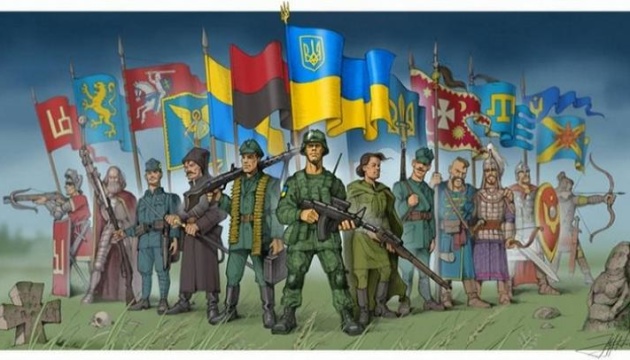Today, Ukrainians celebrate the Christian holiday of the Intercession of the Most Holy Virgin, the Day of Defenders of Ukraine, the Cossack Day, and the Day of the Ukrainian Insurgent Army.
Kyiv. Ukraine. Ukraine Gate – October 14, 2021 – Ukraine Society and Culture
Defender of Ukraine Day is a national holiday celebrated by Ukrainians and was launched on October 14, 2014, with a presidential decree entitled Defender of Ukraine. On July 14, 2021, he has renamed the holiday Defender of Ukraine Day.
The urgency of such a national holiday became especially acute after the Russian occupation of Crimea and the start of hostilities in the Donetsk and Luhansk regions. Unprecedented examples of courage and courage shown by our soldiers on the front lines of the last Russian-Ukrainian war, hundreds of lives dedicated to the Motherland required worthy respect from society and the state.
The date of October 14 was chosen not by chance. This day falls on the Christian holiday of the Intercession of the Blessed Virgin, and in 1999 the Day of the Ukrainian Cossacks was established.
From time immemorial, the Mother of God has been the patron saint of the Ukrainian Cossacks and all Ukrainian armed groups. On the Feast of the Intercession, the Great Council of Ukraine was held, where the Hetman was elected and how the Cossacks lived. The image of the Cossack as a Ukrainian knight and defender of his homeland is close to all Ukrainians.
Already in the twentieth century, the Cossack traditions of the struggle for the independence of Ukraine were followed by soldiers of the Army of the Ukrainian People’s Republic and the Ukrainian Insurgent Army. It is no coincidence that the Feast of Intercession was chosen as the official founding day of the Ukrainian Insurgency Army. Thus, it is quite logical that on this day the ancient heroic past of Ukraine was combined with the heroic present.
Even today, the Ukrainian army retains the fighting traditions of its ancestors, so the army bears names with the names of legendary Ukrainian commanders and famous formations from the past. The longevity of generations is reflected in the elements of the uniform – the Trident Sleeve Headpiece. The slogan “Glory to Ukraine” – “Glory to Heroes” became the official salute of the Ukrainian army.
Eastern Rite Christians today celebrate the Intercession of Our Lady It was introduced into Christianity only in the 10th century and has either a legend or a real event that occurred in ancient Constantinople (Constantinople). At that time the city was surrounded by strangers. Under the vault of the church, the Blessed Virgin Mary, surrounded by angels, prophets, and apostles, appeared at the mass service in the Flahern Chapel and covered the faithful with her astonishing beauty with her beauty. This vision was a harbinger of victory – soon the enemy retreated and the city was saved from destruction. Since then, intercession has been associated with care and protection from the enemy, visible and invisible.
The Zaporozhian Cossacks especially revered the Virgin Mary. They had a church in her honor at, as well as an icon of her intercession. In a campaign against the enemy, the Cossacks sent a prayer to their patron. And after they happily returned from the campaign, they thanked her.
In addition, the Feast of the Intercession was highly respected among the Ukrainian peasants: the second month of autumn was eagerly awaited, because from Prechista, that is, from October 14, the wedding was allowed to celebrate. People said: October is rich in joys, and the month itself is also called “the wedding.”
Many temples were built in Ukraine in honor of the intercession. One of the oldest is the Church of the Intercession in the village of Sotkevka, Khmelnytskyi District, built in 1467 as a fortress. Today, this unique building is a working temple and museum at the same time.
today’s events
Today marks the day of the founding of the Ukrainian Insurgent Army. This date was officially established by the decision of the Ukrainian Main Editorial Board of June 30, 1947, and in connection with the Feast of Intercession, the intention was the patron saint of the Cossack army, to show the inheritance of the Ukrainian army from the Hetmans. However, this date is rather symbolic, since the first battles took place in February 1943. The Ukrainian Insurgent Army, as a military-political structure of the Ukrainian liberation movement, worked until September 1949, after which it was reorganized into an armed company. The United Progressive Alliance fought against both Nazi Germany and the Soviet Union, with its main goal being the restoration of an independent Ukrainian state.
The last battle of the secret army is considered the battle of April 14, 1960, in the Ternopil region. However, later armed resistance continued, and some tunnels operated underground for several decades. In total, more than 100,000 people passed through the ranks throughout his existence, and more than half a million people were subjected to repression by the punitive bodies of the Soviet Union for participating in or supporting the insurgency.
They were born on this day
in Ukraine…
Andrei Zsibon (1978-2014), champion of the Celestial Hundred.
He was born in Kyiv and lived in the Minsk region. He studied at Kyiv Lyceum № 100, where he graduated from the physics and mathematics class. In 1995-2001 he studied at the Radio Faculty of the Kyiv International University of Civil Aviation (now the National Aviation University).
He did not have to work in this profession because in 2000 he got married and had to earn money for the family.
In the winter of 2013-2014, he was an active participant in the Dignity Revolution. He was a member of the martial field.
On the evening of February 20, 2014, Andrei Zipun, together with other activists, was on duty at a checkpoint at the entrance to Kyiv from the Gostomel highway. On the night of February 21, after the shift ended, he returned home by himself. In the morning, his body was found in Kyiv on Verbolozna Street in Korenevka with signs of severe beatings and craniofacial trauma.
Andrew is survived by his wife and son.
Kharitina Pikarchuk (1894-1973), public figure and military, cornet player in the UPR Army. The first woman to be awarded the Ukrainian State Prize of the twentieth century.
She was born in Simferopol in a Polish-Russian family of wealthy landowners. As a schoolgirl who was fond of Ukrainian theater when she worked in the Tavria province, she met like-minded people who were also interested in the Ukrainian subject. Together with them, she founded Simferopol “Enlightenment”. When workers in the expanded port of Sevastopol occupied Simferopol in 1918, it was captured. Before that, she managed to destroy Simferopol’s “Enlightenment” lists so that they would not fall into the hands of the Bolsheviks. It was liberated by the German Allied forces, who later entered the city.
In the days of the Ukrainian state, Tina worked as a printer in the later joined the newly formed regiment, where she received the position of sergeant for assignments. During the uprising in November 1918, she joined Ivan Bohon’s regiment, where she had to take part in the battles against the Bolsheviks with weapons at hand.
In 1919, Tina married Ivan Pikarchuk, an officer in the UPR army. In the same year, in the battle against the Denikinite, she was wounded in the abdomen and returned to the regiment three weeks later with a wound that did not heal. In the winter campaign of 1919, as a member of the 1st 100th Cavalry Regiment Mazepa of the UPR Army, she was awarded the Order of the Iron Cross and the Liberation Struggle – Cross of Simon Petliura.
In the summer of 1920, she received a severe bruise, which almost paralyzed the left side of the body. “This ended my service to Ukraine as a soldier,” she said in her diary.
In the fall, the Poles arrested Tina Pikarczuk, and at the end of 1921, she ran away to her husband, who was seriously ill at that time. The couple lived illegally, hiding from the police, and Kharitina earned a living for herself and her husband.
Later, Kharitina tried to make up for the lost time and get an education, she even studied at the Faculty of Philosophy for some time. But because of tuberculosis, she had to leave school and move to the Republic of Poland.
During World War II, Becharshoks tried to return to Ukraine. In Vinnytsia, Khristina organized and headed the Women’s Service in Ukraine. In 1943, she and her husband were arrested by the Gestapo on charges of links with guerrillas. But due to a lack of evidence, the couple was released within a few months, after which the Bekarchuk couple fled to the west and wandered around the camps for the displaced.
Read Also: How to Make a Holiday With Children Fun, Useful and Interesting
Source: Ukrgate







